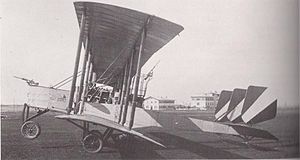Caproni Ca.3
| Caproni Ca.3 | |
|---|---|

| |
| Caproni Ca.36 | |
| Role | Heavy bomber |
| Manufacturer | Caproni |
| First flight | 1916 |
The Caproni Ca.3 was an Italian heavy bomber of World War I and the post-war era. It was the definitive version of the series of aircraft that began with the Caproni Ca.1 in 1914.
Development


The development of the Ca.1 to the Ca.2 suggested the benefits of increasing amounts of power to the very sound airframe. The Ca.3 was a development of Ca.2, by replacing the two engines mounted on the booms with the same Isotta-Fraschini engine that had been used as the central, pusher engine on that design.
The prototype flew in late 1916 and was soon put into production. Known to Caproni at the time as the Caproni 450 hp, the Italian Army designated it the Ca.3. In Caproni's post-war redesignation, it became the Ca.33. Somewhere between 250 and 300 of these aircraft were built, supplying the Italian Army and Navy (the latter using the type as a torpedo bomber), and the French Army. Late in the war, Robert Esnault-Pelterie built the type under licence in France, building an additional 83 (some sources say only 19) aircraft.
Note: there is some variation in published sources over early Caproni designations. The confusion stems, in part, from three separate schemes used to designate these aircraft - Caproni's in-house designations of the time, those used by the Italian Army, and designations created after the war by Caproni to refer to past designs.
Description
The Ca.3 was a three-engined biplane of wooden construction, with a fabric-covered frame. The crew of four was plaved in an open central nacelle (front gunner, two pilots and rear gunner-mechanic). The rear gunner manned upper machine guns, standing upon the central engine in a protective "cage", just in front of a propeller. Tricycle landing gear.
Armament consisted of two to four Revelli 6.5 mm or 7.7 mm machine guns, one in front ring mounting and one, two or sometimes even three in an upper ring mounting. Bombs were suspended under the hull.
Operational history
The Ca.1 entered service with the Italian Army in the middle of 1915 and first saw action on 20 August 1915, attacking the Austrian air base at Aisovizza. 15 bomber squadrons (1-15 Squadriglia) were eventually equipped with Ca.1, Ca.2, and Ca.3 bombers, mostly bombing targets in Austro-Hungary. The 12th squadron operated in Libya. In 1918, three squadrons (3, 14 and 15) operated in France.
Apart from the Italian Army, Caproni Ca.3s were also used in British squadrons, before the introduction of the Handley Page Type O bombers. Original and licence-built ones were used by France (original Caproni were used in French CAP escadres, licence-built examples in CEP escadres). They were also used by the American Expeditionary Force.
Some of the Ca.36Ms supplied after the war were still in service long enough to see action in Benito Mussolini's first assaults on North Africa.
This plane is also remembered for a tragedy on May 4, 1919, which killed the French General Dr. Milan Rastislav Stefanik, who was the minister of war in the Czechoslovak Republic at the time. The accident occurred at the conclusion of a flight to Campo Formido near Udine to Bratislava (capital of Slovakia). On his initial approach, the pilot determined that the ground was too wet to land on, so he increased power to the engines and began to aim the plane to a landing patch further afield which appeared to be dry. While doing so, one of the engines exploded, causing the aircraft to nosedive. General Stefanik and the three Italian crew members were pronounced dead at the scene. A subsequent investigation determined that the most likely cause of engine failure was due to a failure of the air blast cooling of the engine, probably induced by the increased strain cause by the pilot's sudden demands on the engine after the aborted landing. There were allegations that a Czech anti-aircraft artillery company had fired on the craft, either because they mistook the plane's Italian markings for Hungarian markings or that they had done so as part of a conspiracy to see Gen. Stefanik killed in order to prevent him from putting forth proposed changes in the Czech government. These allegations were never proven, and the failure of the engine's blast cooling is widely accepted as the best explanation for the accident.
Variants
All of the following designations were applied after the war. At the time, all were known as the 300 hp by Caproni and the Ca.3 by the Army.
- Ca.34 and Ca.35 with a modified central nacelle to seat the two pilots in tandem and therefore improve aerodynamics. No production.
- Ca.36 with removable outer wing panels for ease of storage.
- Ca.37 - prototype single-engined two-seat ground attack aircraft
- Ca.39 - seaplane version. No production.
- Ca.56a - airliners created by re-manufacturing war-surplus Ca.3s.
Operators
Survivors
- National Museum of the United States Air Force at Wright-Patterson AFB near Dayton, Ohio
- Italian Air Force Museum at Lake Bracciano (Latium)
- Vojenské historické muzeum in Piešťany, Slovakia (replica)
Specifications (Ca.36)
| This aircraft article is missing some (or all) of its specifications. If you have a source, you can help Wikipedia by adding them. |
Data from [citation needed]
General characteristics
- Crew: 4 (pilot, co-pilot, front gunner, and rear gunner/mechanic)
Performance
Armament
- Guns: 2 × 6.5 mm or 7.7 mm FIAT-Revelli machine guns
- Bombs: 800 kg (1,760 lb) of bombs
See also
Related development
Related lists
